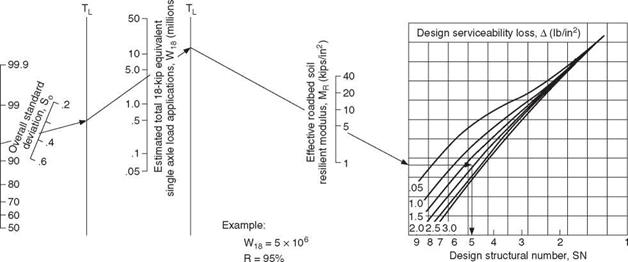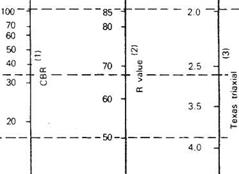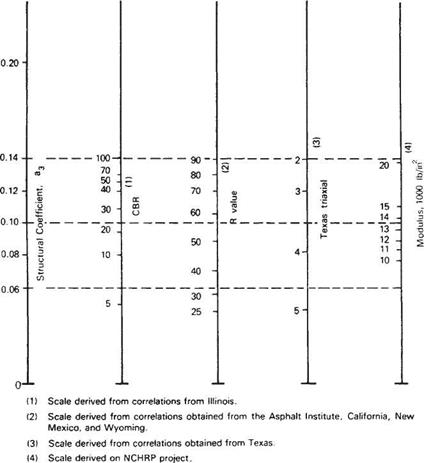Pavement Deterioration
Pavement deterioration or distress can be classified into two basic categories for all pavement types—structural and functional. The most serious category is structural. Structural deterioration results in reduced ability to carry load and a decreased pavement life. Functional deterioration can lead to and accelerate structural deterioration, but it is only related to ride quality and frictional characteristics. A third type is environmental deterioration, which is a form of material-related distress. Environmental deterioration affects pavement materials and will generally exhibit itself as either functional or structural deterioration.
 |
|
|
|
|
|

S0 = 0.35 MR = 5000 lb/in2 Д (lb/in2) 1.9 Solution: SN = 5.0
FIGURE 3.17 Design chart for flexible pavements based on using mean values for each variable. Conversions: 1 kip = 4448 N, 1 lb/in2 = 6.895 X 10-3 MPa, 1 kip/in2 = 6.895 MPa. {From Guide for Design of Pavement Structures, American Association of State Highway and Transportation Officials, Washington, D. C., 1993, with permission)
|
||||||||||||||||||||||||||||||||
|
|
|
|
|
![]()

![]()
![]()

(1) Scale derived by averaging correlations obtained from Illinois.
(2) Scale derived by averaging correlations obtained from California, New Mexico, and Wyoming.
(31 Scale derived by averaging correlations obtained from Texas
(4) Scale derived on NCHRP project.
FIGURE 3.19 Variation in granular base layer coefficient (a2) with various base strength parameters. Conversion: 1 lb/in2 = 6.895 X 10~3 MPa. (From Guide for Design of Pavement Structures, American Association of State Highway and Transportation Officials, Washington, D. C., 1993, with permission)
Pavement deterioration is an important measurement for a pavement engineer. To determine the remaining life of a pavement, or the amount of pavement repair required to extend a pavement life for a given time period, or the most appropriate time for pavement repair, the amount and type of deterioration in a pavement must be measured. Methods of measurement of pavement deterioration vary, but most are similar in that they all require a visual inspection of the pavement and a somewhat subjective distress rating.
|
FIGURE 3.20 Variation in granular base layer coefficient (a3) with various subbase strength parameters. Conversion: 1 lb/in2 = 6.895 X 10_3 MPa. (From Guide for Design of Pavement Structures, American Association of State Highway and Transportation Officials, Washington, D. C., 1993, with permission) |








Leave a reply